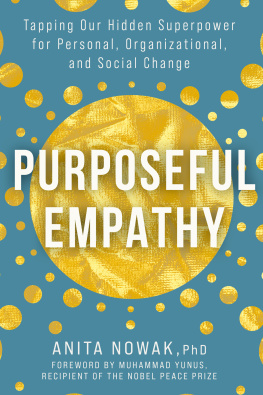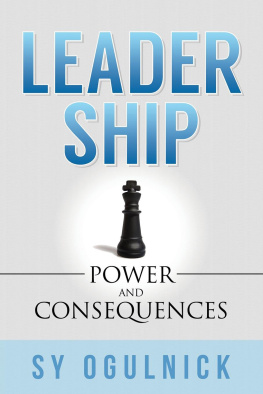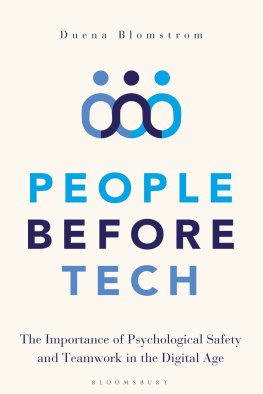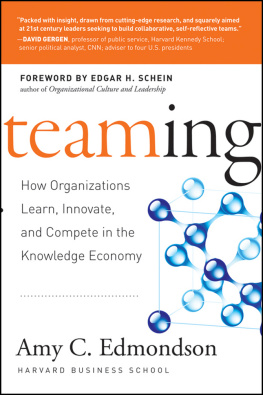THE 4 STAGES OF
PSYCHOLOGICAL
SAFETY
Timothy R. Clark
THE 4 STAGES OF
PSYCHOLOGICAL
SAFETY
Defining the Path
to Inclusion and Innovation

The 4 Stages of Psychological Safety
Copyright 2020 by Timothy R. Clark
All rights reserved. No part of this publication may be reproduced, distributed, or transmitted in any form or by any means, including photocopying, recording, or other electronic or mechanical methods, without the prior written permission of the publisher, except in the case of brief quotations embodied in critical reviews and certain other noncommercial uses permitted by copyright law. For permission requests, write to the publisher, addressed Attention: Permissions Coordinator, at the address below.

| Berrett-Koehler Publishers, Inc.
1333 Broadway, Suite 1000
Oakland, CA 94612-1921
Tel: (510) 817-2277, Fax: (510) 817-2278
www.bkconnection.com |
Ordering information for print editions
Quantity sales. Special discounts are available on quantity purchases by corporations, associations, and others. For details, contact the Special Sales Department at the Berrett-Koehler address above.
Individual sales. Berrett-Koehler publications are available through most bookstores. They can also be ordered directly from Berrett-Koehler: Tel: (800) 929-2929; Fax: (802) 864-7626; www.bkconnection.com
Orders for college textbook/course adoption use. Please contact Berrett-Koehler: Tel: (800) 929-2929; Fax: (802) 864-7626.
Distributed to the U.S. trade and internationally by Penguin Random House Publisher Services.
Berrett-Koehler and the BK logo are registered trademarks of Berrett-Koehler Publishers, Inc.
First Edition
Paperback print edition ISBN 978-1-5230-8768-6
PDF e-book ISBN 978-1-5230-8769-3
IDPF e-book ISBN 978-1-5230-8770-9
Digital audio ISBN 978-1-5230-8771-6
2020-1
Cover designer: Travis Wu and Kirk DouPonce; Author photo credit: Chelsie Starley; Book producer and text designer: Leigh McLellan Design; Copyeditor: Karen Seriguchi; Indexer: Ken DellaPenta
To Tracey
Contents
Preface
This book puts forward a theory of human interaction. Let me give you the context. Several years ago, my wife, Tracey, and I returned to the United States from England as I neared the completion of a PhD in social science at Oxford University. The ramen budget was gone. I would get a job, work for a year, finish my dissertation, teach at a university, and live happily ever after. That was the plan.
Heres what actually happened. I stepped out of the ivory tower into the gritty, sweaty megaton realm of a steel plant. Constructed by US Steel Corporation during World War II, Geneva Steel was the last fully integrated steel mill west of the Mississippi River, a hulking mass of machinery spread across 1,700 acres, the industrial equivalent of the Vatican, a self-contained enclave within a larger metropolis, with its own trains, fire station, hospital, and towering blast furnace cathedral. The plant manufactured steel plate, sheet, and pipe used to make everything from bridges to bulldozers. With my working-class sympathies, I thought I knew what I was getting into. I didnt have a clue.
Key questions: Have you ever been dropped into a completely foreign environment? Were you suspicious of the natives? What bias or prejudice did you bring?
This was another world. I found myself working with shift-work-hardened, layoff-endured welders, millwrights, pipefitters, and crane operators. These shadows under the hardhats became my friends, but there was nothing romantic about this heaving, grinding, snorting place. The shop floor was a high-stakes, no-margin-for-error arena where precision mattered and assumptions could kill. With thousands of safe-job procedures to govern every task for every job in every operation, nothing was left to chance. They preached safety so incessantly, it was easy to stop believing.
Then came the fateful day. A maintenance worker was crushed under a sixteen-ton load of iron ore pellets. He died instantly. I remember wondering what agony would sweep through the mans family. Later that day, I was given the assignment to accompany the CEO to deliver the dreadful news. We learned later that this tragedy was the result of several employees breaking safety rules. In the days ahead, safety would become my obsession, but not in the way you might think. I would come to learn that psychological safety is the foundation of inclusion and team performance and the key to creating an innovative culture.
With my degree in hand, it was time to leave the mill and trade my hardhat and steel-toed boots for tweed, chalk, and the classroom. Then something unexpected happened. The CEO asked me to become the plant manager. Now I faced an unusual decision: Settle into the tranquil life of an academic or lead a team of 2,500 employees working in the bowels of an industrial beast. Tracey and I decided to accept the offer. Why? Because it represented a rare opportunity to study human behavior in a unique setting as a participant observer. The experience would thrust me into a real-world tutorial and challenge the elegant theory I had learned at Oxford.
On my first day as plant manager, I called to order the morning operating meeting and came face to face with the indigenous culture. A stoic silence fell over the room as I peered into the faces of twenty superintendents, many of whom were old enough to be my father. Now they reported to me.
They had been deeply socialized to self-censor, constrained by deference to positional power and a slavish adherence to the chain of command. Power mattered. And these men (and they were all men) understood where power lay. It lay with me. Despite my youth and Experience had taught these managers that it was emotionally, politically, socially, and economically expensive to say what they really thought, so they smiled and nodded politely.
Key questions: Have you ever been in a position of power? Have you ever been in a position of no power? Did having power or not having power change your behavior?
Inhabiting this fertile setting for field study was a social scientists dream. What I was observing cried out for interpretation. But I had to be more than an observer; I had to be a reformer. To improve the companys performance, we needed a transformation. The tired old plant was struggling to compete with the mini-mills that had disrupted the industry and were dominating the market. To increase throughput and yield, we needed to vacate the rules of naked force and disabuse people of their worship of coercive authority and their inclination to induce fear through intimidation. The entire organization needed to be cleansed from its status-bound model of authoritarian rule. Defang the place or die in the next downturn.
Commercial organizations survive by maintaining competitive advantage, which ultimately means incubating innovation. If you watch closely, you will notice that innovation is almost always a collaborative process and almost never a lightbulb moment of lone genius. As the historian Robert Conquest once said, What is easy to understand may have not been easy to think of.
Most leaders dont comprehend that managing these two categories of friction to create an ecosystem of brave collaboration is at the heart of leadership as an applied discipline. It is perhaps the supreme test of a leader and a direct reflection of personal character. () Without skill, integrity, and respect for people, it doesnt happen. Nor can perks such as foosball tables, free lunch, an open office environment, and the aesthetic of a hip organization bring it to life.
Next page







